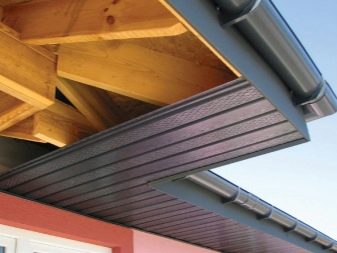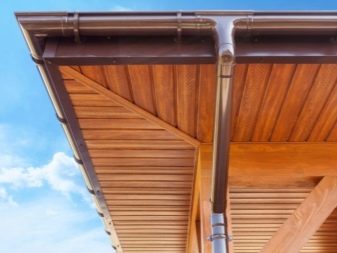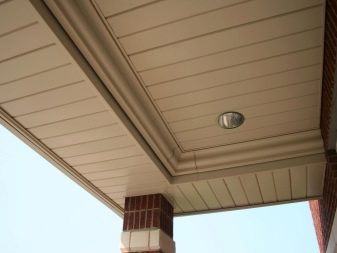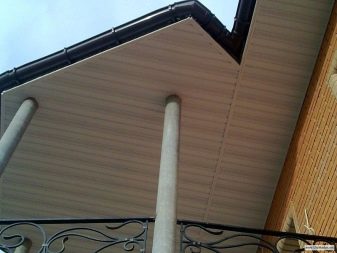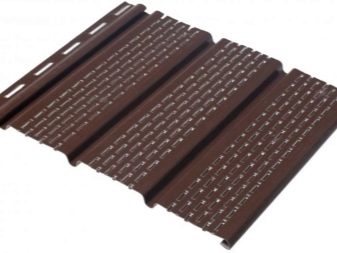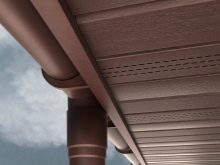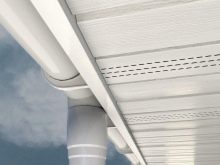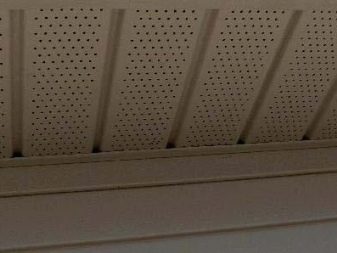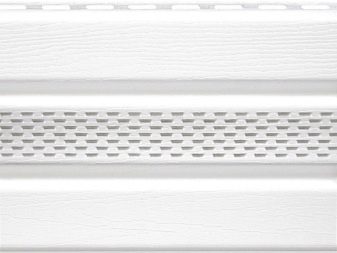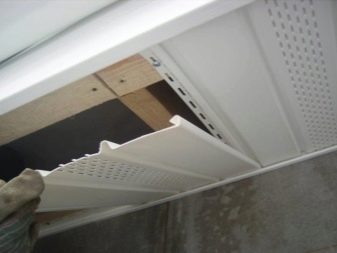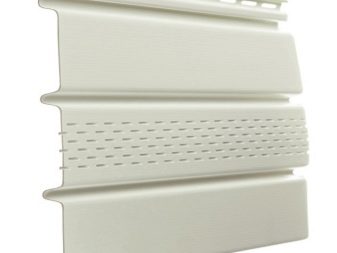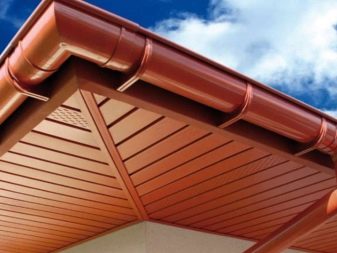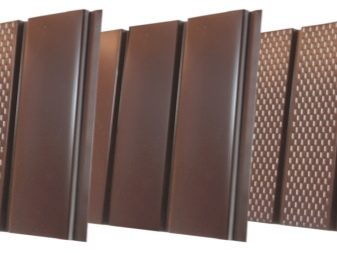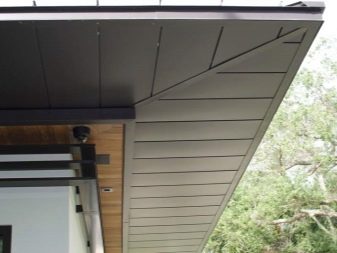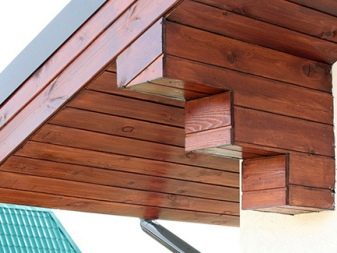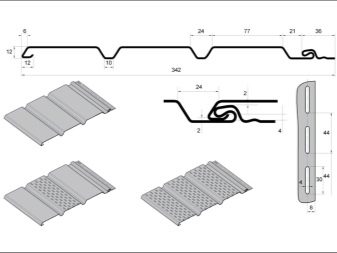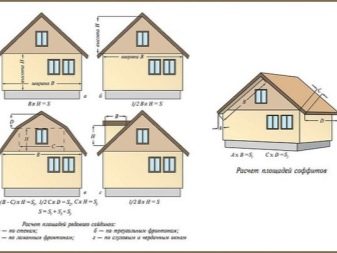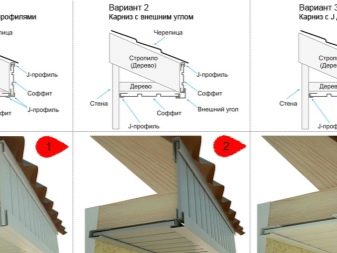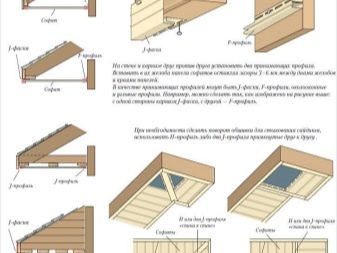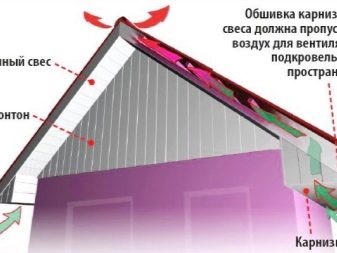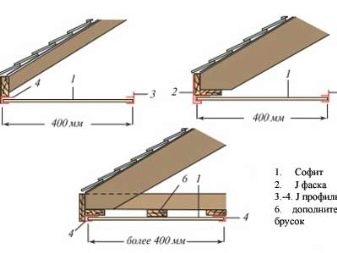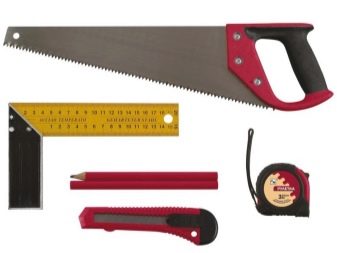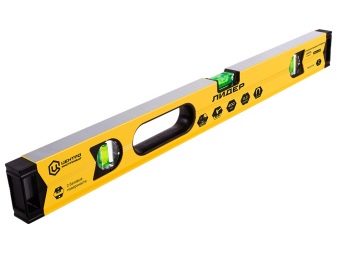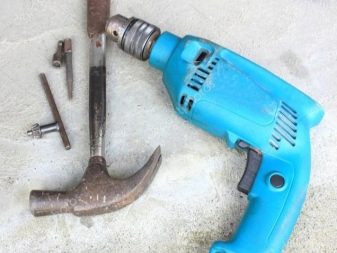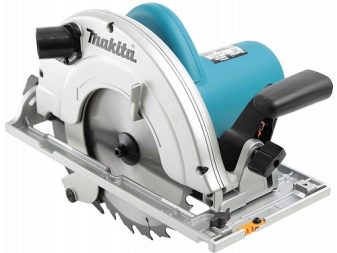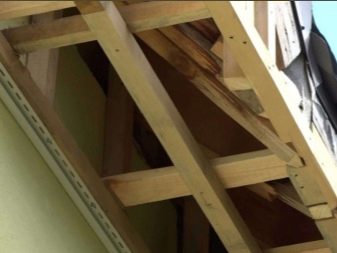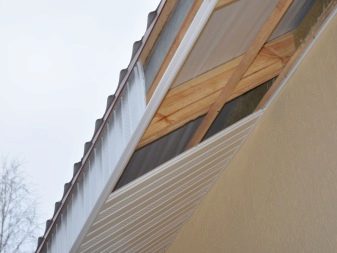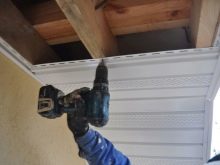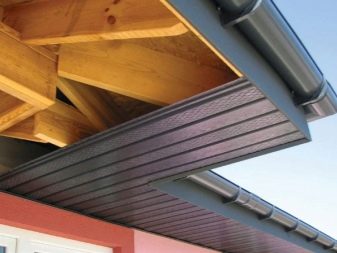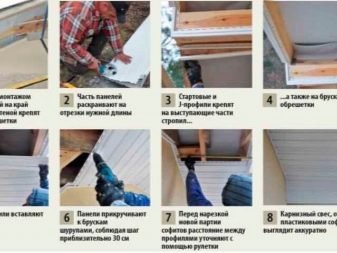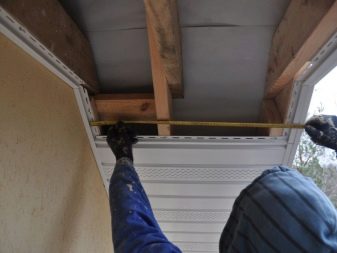Soffits for filing the roof: the subtleties of roofing
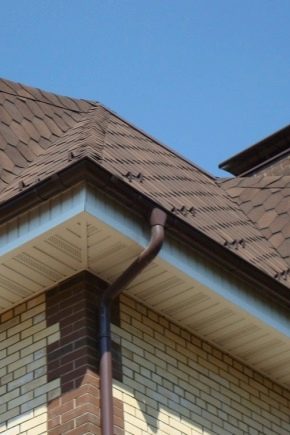
Roof overhangs are stitched mostly for aesthetic reasons, but this is far from the only reason. Overhangs are also designed to protect the roofing “pie” from the effects of wind and moisture. To simplify the process of filing, were invented spotlights.
Special features
Soffits are panels that can be made of various materials: metal, wood, polymers. Their mission - filing of overhangs, both of eaves, and pediments. Not so long ago, only eaves overhangs could be hemmed, since they did not hold on the gables, but the design was refined and now it is possible to place the spotlights around the entire perimeter of the overhangs.
Of course, there are more traditional materials used for finishing the overhangs: lining, board, siding and the like. Soffits compare favorably with them, since they were previously developed so as to create a suitable microclimate under the roof., guarantee better ventilation of the roofing pie. Another advantage is the increased soffit length. They can reach 80 cm. Neither the panel nor the board can boast of such.
The advantages of using spotlights are as follows:
- Strength. Soffits are resistant to loads, including wind.
- Ease of care. For soffits do not have to care. It will be enough to wash them a couple of times a year with soapy water.
- Resistance to environmental influences. Soffits practically do not fade under the sun, unlike siding, which greatly changes its color after a long stay under the sun. Also, spotlights do not shrink and do not expand depending on temperature differences.
- Variability of use. Soffits are suitable not only for exterior decoration, but also for interior. They will also be interesting to look at when placed on the territory of the veranda or terrace.
- Easy installation. No specific knowledge is needed to properly fix the spotlights in the proper places.
- Attractiveness. Soffits look good even without subsequent finishing, as they were originally intended for facing overhangs.
- Resistance to microorganisms. Neither the fungus, nor the mold does not affect the spotlights due to the processing with a special agent that prevents the spread of such organisms.
- High level of protection. Soffits protect not only the overhangs of the roof, but also those communications that are located under it and on the walls.
- Resistance to temperatures. The temperature amplitude at which spotlights can be used is extremely large. It varies from -60 to +120 degrees.
In addition to the advantages, there are some drawbacks for spotlights, although not so numerous:
- We'll have to constantly check in what condition they are. Due to the presence of perforations, all kinds of garbage can fly into them, clogging up the existing ventilation holes. Also, the wind can penetrate through the perforated holes, loosening the spotlights and disabling them.
- Once every five years you have to completely replace all the plates.
- Soffits are quite expensive, so save them will not work. Even with the condition of self-assembly, the cost will still be impressive.
- Unlike other materials used for filing, the spotlights will not be shortened. Perforation on them is located in a certain order and its violation leads to the fact that some of the operational properties will be lost.
Device
Depending on the design features, completely closed, partially perforated and fully perforated soffits are distinguished. Each of the constructs is designed for installation in a specific place of the roof.
- Soffits without perforation should be installed on those areas where precipitation falls: rain, snow. Such patina sheathe pediments, as well as the vertical walls of the eaves.
- Partially perforated panels are justly universal. With their help, you can sheathe not only overhangs, but also ceilings. By the way, often spotlights with partial perforations are chosen for covering the ceilings of terraces and verandas.
- Fully perforated panels are suitable for trimming the inside of the roof overhangs.It is important that there is no sediment access to these areas, otherwise the water will get inside the roofing cake, which will cause the layers to rot. However, the holes are not so large that birds or large insects can fly into them.
All spotlights, with the exception of home-made, have special locks, with which they are attached to each other. Also with the help of the same locks they are attached to the frame of the overhangs. After the fixings are fixed, and the soffit is installed, the locks are not visible. You should also take into account the fact that the wider the spotlights, the easier it is to mount them and the installation can be made in a shorter time.
As you can see, the soffit device is quite simple: it is a panel with or without perforations. However, deceptive simplicity should not confuse you. The perforation is arranged in a certain order, and in case of its violation, the ventilation properties of the spotlights will be under serious threat.
Kinds
To date, there are several types of spotlights. The basis for the classification served as the materials from which the panels are made.
Plastic
In everyday life, this type of spotlights is better known as vinyl.Such products are the most popular due to their lightness, durability, wide choice of colors and affordable prices. The advantages of vinyl spotlights include the following:
- Material does not rot and does not corrode. Vinyl, unlike metals, has a completely different composition, so it is not subject to such changes.
- Does not burn. Plastic melts, but does not burn, so that it does not support burning. In addition, special compounds are added to the material from which soffits are made, which increase the melting point.
- Does not conduct electricity. Due to this quality, there are no risks to get an electric shock if water gets on the plastic soffits. It so happens that they are used for the ceiling lining, and under this lining is the wiring. In these cases, the absence of electrical conductivity is a significant advantage.
- Ease of installation and maintenance. Installing panels and taking care of them in the future is easy. Vinyl products are lightweight, so you can even mount them alone.
- Resistance to load. A brief forceful impact will not bend and break the bar, but this does not mean that you can beat and knock on the vinyl soffits.They are not designed for shock loads, but perfectly tolerate atmospheric effects: rain, hail and snow, strong gusts of wind, the weight of a snow cap.
- Environmental Safety. The plastic used for the production of spotlights does not emit toxic substances into the atmosphere that are harmful to the environment and to humans, so it does not harm the environment.
- Long operational life. Manufacturers claim that vinyl panels can last up to 50 years, but this statement is easily questioned, since every five years they need to be replaced with new ones.
You can clearly see that the choice of vinyl spotlights is a wise decision.
Metallic
Metal soffits can be made of three metals: copper, aluminum and galvanized steel. Aluminum soffits are the most popular today. Thanks to their advantages, it is possible to decorate the overhang by getting a neat and aesthetically attractive cornice. So, to the pluses include:
- Easy installation. This item can be easily challenged, considering how easily the aluminum panel bends and deforms, but in the case of careful transportation to the installation and installation site, the installation is not alone, it really turns out to be quite simple.
- Ease of operation.It is easy to care for aluminum panels due to the special coating they have, but they need to be washed carefully, without pressure, because the soffit from aluminum is easy to bend. Therefore, the same reason can not be used for washing high pressure washer.
- Large selection of colors and durability. To begin with the fact that aluminum products are available in a huge color range. Special processing technology allows them to retain their color for a long time under the constant influence of ultraviolet radiation.
- Resistance to burning. Aluminum does not burn, but it is very hot.
- Resistance to temperature changes. Aluminum is able to withstand any temperature that is inherent in the Russian climate, but like any metal, aluminum shrinks when cooled and expands when heated. Because of this feature, aluminum soffits should not be mounted on homes in areas with extremely cold winters and unbearably hot summers.
Like aluminum soffits, steel versions can be made in a huge number of colors. Among other things, they are deprived of one important drawback: steel panels are much more difficult to bend than aluminum ones.By the way, and they have a significantly greater weight.
As for copper products, in addition to the interesting appearance, they are distinguished by an extremely long service life.
As some experts say, copper soffits can last up to 150 years without losing their operational properties. Since copper itself is expensive, and spotlights are well. For each square meter of material you will need to pay 2 500 or more rubles.
Wood
Wood panels are used not so much for practical as for decorative purposes. These options look best on log houses or timber houses, although they also look quite good on brick structures. However, the tree in this case has more disadvantages than pluses:
- The tree is extremely sensitive to moisture. Even after being processed according to all the rules, this material will still swell, rotting.
- Another stumbling block are parasites. Drevototsy able to completely spoil the appearance and characteristics of such products, as well as wooden soffits are attacked by rodents.
- On wooden surfaces, fungal and mold microorganisms quickly spread.If the mold gets into the ventilation, then the roofing pie can also be spoiled.
Among other things, there are several varieties of spotlights, depending on their size. There are no standard model dimensions, however, it is immediately possible to distinguish which company produced the spotlights - Russian or foreign. So, in Russia, the best is considered the width of the spotlights 50-80 cm, but this does not mean that the models are not widely available. Just have to look for them.
As for foreign products, its width and length are clearly defined: 30 cm wide and 360 cm in length. Such sizes are considered the most convenient and fit well to almost any cornice.
As for the thickness, it can be as high as 0.6 mm for aluminum samples, and up to 1.2 mm for vinyl samples. There is no general meaning for wooden soffits.
How to calculate the required amount?
The easiest way to calculate the required number of spotlights is to use a special program that is designed for this. In it you need to select parameters such as:
- type of roof;
- the presence of a warming layer;
- the width and length of the slope or slopes, if the roof is multi-sloped;
- material of which the spotlights are made;
- overhang dimensions;
- roofing material.
If for some reason you do not have access to such programs and you want to use the manual calculation method, then use the following instruction. For example, take the most common gable construction:
- Make measurements of the gable and eaves overhangs. To simplify the calculations, we denote the eaves overhang by the letter D, and the gable overhangs by the letter B. For example, D = 20 m, and B = 10 m.
- Next, you need to find the perimeter of the overhangs, which is denoted by the letter L. In our case, L = 20x2 (two lengths of cornices D) + 10x4 (four lengths of gables B) = 80 m.
- Further, the width of the overhang is measured. This value (denoted by A) shows how far the overhang is from the wall. For example, take the standard indicator A = 0.5 m.
- After the basic values have been obtained, the overhang area can be determined: S = 80x0.5 = 40 m.
- To determine how many sheets of soffit will be needed, it is necessary to consider what material they will be made of. It is not possible to consider the calculation for each individual sample being produced, so we take the most common option - metal soffits with dimensions of 300x32.5 cm. To calculate how many pieces you need (denoted as K), you need to divide the area of the overhangs by the spotlights sheet: K = 40 / 0.975 = 41.03 pieces.Round up - 42 spotlights.
In addition to spotlights, you will need some additional elements:
- Groove or J-Profile. It is necessary to divide the perimeter L by the length of the profiles (3 m): 80/3 = 26.67 pieces. Round up - 27 pieces.
- Head plate. The number is determined in the same way as for the grooves: the perimeter of the spotlights is divided by the length of the strip (3 m) of the spotlights. 80/3 = 26.67 pieces. Round up - 27 pieces.
- Finishing plate. The quantity is determined similarly. The length of the finishing bar is 3 m. So, 80/3 = 26.67 pieces. Rounding, we get 27 pieces.
Total will need 42 spotlights and 27 slots, finishing and frontal slats.
Instruments
For installation of spotlights do not have to purchase expensive equipment. You can use the fact that there is in the house of almost every owner:
- Building level. Most preferably, if there is both a level and a laser level in stock. By checking the horizontal in two levels alternately, it is possible to accurately determine how exactly the spotlights fit.
- Roulette. It is needed for marking. Also, with its help, measure how much you need to cut from the soffit sheet.
- Construction knife. It is used for trimming small areas where accuracy is important.To cut large pieces, it is better to use other tools.
- Ruler-corner and protractor. Such tools, familiar to everyone from school, are used to mark the corners. When cutting spotlights, it is important that each corner exactly corresponds to the required value, otherwise gaps are formed between the parts or, on the contrary, they will overlap.
- Hammer. It is best to use a small metal carpentry tool.
- Scissors for metal. Like a construction knife, scissors are designed for cutting small parts.
- Small hacksaw for metal. With it, you can quickly saw off the desired piece of medium size. When working with this tool, it is important to cut only by marking, so as not to remove too much.
- Drill and screwdriver. The first tool is required when working with dowels, and you will need to pre-drill holes. The screwdriver is necessary if you plan to make fastening on the screws.
- A circular saw. Before starting work, you need to stock up on a diamond disc, as it cuts metal parts best.If you chose vinyl spotlights, then regular discs will do.
Installation
The simplest is the classic process of filing the overhangs with spotlights. Such a hemmer will be able to do even a beginner with his own hands. To do everything correctly, easily and quickly, use the following instructions:
- To start it is necessary to build a wooden frameon which any soffit panels are mounted. For such a framework, wooden bars with a cross section of 0.05 m will be needed. Variations with a cross section are unacceptable: the roof will not withstand too heavy bars, and too light boards will not withstand the weight of spotlights and snow load.
- Markup is done. Labels should be applied not only on the mills and overhangs, but also on the soffit sheets themselves. It is important to note exactly where the attachments will be, and then correlate these labels. So the whole structure will be smooth and neat.
- Fixed wooden crate. The timber can be fixed in several ways, but it is best to use ordinary nails when fixing on brick walls or dowels when fixing on CIP panels, wood, foam blocks.
- Fitted J-profile with grooves. Its purpose is to preserve the rigidity of the whole structure.
- Binder panels are installed. It is better to fasten them with screws, nails, screws. It is imperative to leave a compensation gap between the panels and the batten in order to provide the necessary level of ventilation, as well as the fate of an amendment to the expansion of materials.
- Finishing strips are installed. This is done for decorative purposes so that the seams look more attractive.
After installation, it is necessary to assess the quality of the work done: view all the joints for unnecessary gaps, check the evenness of the panels using the level.
Next spotlights are wiped from dust and chips. After that, it can be argued that the overhangs are hemmed.
Tips
Specialists share some recommendations designed to simplify the installation and maintenance of spotlights:
- Additional elements and fasteners must be of good quality. Neglect of this rule is fraught with the fact that the whole structure will look bad and will not last long.
- Filing of overhangs with spotlights should be carried out only after the walls are fully insulated and sheathed.Such a measure is due to the fact that the crate is mounted on the finished walls, and in the future it will be impossible to finish the walls according to all the rules.
- Construction details of the batten should be properly processed. To do this, use an antiseptic. It will not allow rot, mold and fungus to spoil the details of the structure.
- All self-tapping screws, nails and screws used for fixing soffit sheets should be made of stainless steel so that they are not struck by rust and they do not lose their aesthetic appeal and reliability.
- Be sure to leave a small gap between all the details of spotlights. This will help to avoid their deformation in case any of the parts undergoes expansion under the influence of the temperature factor.
- During the execution of all work on the installation or dismantling of spotlights, it is necessary to adhere to safety measures: use a mask, goggles and gloves.
- After the five-year service life of the spotlights, it is necessary to inspect them, remove and replace damaged panels, wipe the rest and leave them until the next inspection. Soffits from some manufacturers can serve up to 50 years, so such a frequent replacement is not needed.
By following all the recommendations and adhering to the installation instructions, you can easily install the spotlights as correctly and quickly as possible.
For details on how to properly hem the roof with soffits, see the next video.


